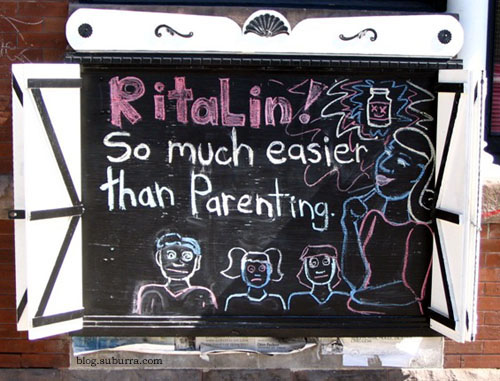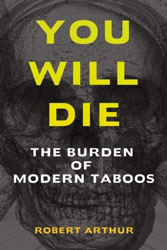Posted: September 29th, 2007 | Filed under: drugs, Ritalin | 1 Comment »

Defaming Parents Who Treat Their ADD Children
Even though studies repeatedly show stimulants such as Ritalin are effective in treating attention deficit disorder (ADD) narcophobes continue to portray its usage as the doping of children.
In 2005 I had a co-worker tell me, “ADD? Isn’t that just a made up excuse?”
No, it is not. There is a difference between a child misbehaving and a child who literally cannot stop turning somersaults in her chair during class despite being mocked by classmates and reprimanded. (As a teacher I witnessed this remarkable gymnastic display.) There is also a difference between a child who does not like reading and a child who cannot focus enough to read and comprehend one page in a book. For teachers responsible for educating these children the difference is obvious.
People say that in the “good” old days those children got a good whopping from their parents. Drugs weren’t necessary. Yes, that did occur and it still does. However, in the “good” old days those kids also dropped out of school. (In 1960 41.1.% of the adult population had a high school degree. In 2004 85.2% did. Truancy laws began being vigorously enforced in the mid-1990s, e.g. the ACT Now program.) In this age of “no child left behind” EVERY child is expected to sit still in class until they graduate so they can be all they can be.
A widespread misconception is that Ritalin is a sedative that will zombify any child. This attitude was displayed on a store’s sign that I passed this month. (See photo.) Ritalin, like other stimulants (Adderall, caffeine, cocaine), that allow those with ADD to focus and sit still have the opposite effect on normal people. Stimulants make people without ADD hyper, ergo their name. In addition, overprescribing Ritalin and other stimulants to those with ADD will make them hyper as well. A parent would be making their parental duties hellish if they were improperly giving their children Ritalin.
Sources:
-
“Fourteen months out, the kids given medication alone or stimulants plus behavior management were doing much better than those who got just therapy or other care in the community.” Marilyn Elias, “Kids Treated for Attention Deficit Get Better in a Few Years,” USA Today, 20 July 2007.
-
David Hamilton, “Commentary: Dropout Rates Have a History We Need to Look At,” Albuquerque Tribune, 25 Sep. 2007.
Posted: September 26th, 2007 | Filed under: cocaine, drugs, ecstasy, LSD, marijuana | 1 Comment »
This month I attended a party. At this affair numerous successful adults from an array of professional backgrounds used illicit recreational drugs that included cocaine, ecstasy, ketamine, LSD, marijuana, mushrooms, and nitrous oxide. There were no minors involved. No one used these substances and drove. No one got hurt or overdosed. Many had used these substances for years without being harmed and without becoming addicted. Despite having a delightful time with these drugs, all of the users were able to stop their merrymaking and return to their jobs sober.
Posted: September 5th, 2007 | Filed under: DEA, drugs, media bias, steroids, Uncategorized | Comments Off on Scapegoating Drugs: Steroids
Chris Benoit
Not much has changed in 75 years when it comes to blaming drugs for heinous murders. In the 1930s it was Henry Anslinger trying to drum up funding for the precursor to the Drug Enforcement Administration (DEA). He would tell the media and congress that marijuana was responsible for gruesome homicides by twisting isolated incidents. The media and congress didn’t care that doctors called these claims bogus because sensationalizing and fear mongering brought them readers and votes.
In 2007, only conservative squares that don’t read can still believe the DEA’s continuing demonization of marijuana. However, just as most of mainstream America was not familiar with marijuana when Anslinger made those fantastic allegations, in 2007 most of mainstream America is not familiar with steroids and so the game is played.
On June 26, 2007, the professional wrestler Chris Benoit, “The Canadian Crippler,” was found dead in his Georgia home along with the corpses of his wife and seven-year-old son. Benoit had killed them both and then strangled himself. As every narco-phobe knows professional wrestlers have big muscles and big muscles means steroids and steroids means “roid rage.” When anabolic steroids were found in the house the stories could write themselves.
A leader of the charge was the commentator, Bill O’Reilly. The popular O’Reilly has built a reputation on using “common sense” instead of research and facts to provide a “no spin zone” for his viewers. (For examples of his common sense trumping facts go to the Bill O’Reilly Page at Media Matters.) On June 27 O’Reilly had a former professional wrestler, Jon Stewart, on The O’Reilly Factor to discuss Benoit.
O’Reilly asked Stewart about Benoit and it immediately became apparent the angle O’Reilly wanted:
Stewart: …. Chris was a very pensive, quiet guy, a work horse in the industry. And this is completely out of what I’ve known of him and his character.
O’Reilly: OK, but you did know that he was on steroids. And you know, once you get into that world of narcotics, illegal drugs, whatever you want to call them, your personality changes. Correct?
Stewart tries to provide more context to the story but O’Reilly keeps him on point:
Stewart: …. the mix of steroids, this gladiator mentality that we have, the way the public treats us that, you know, they’re not — we’re not held to any rules of society. Bill, is that a really lethal combination [sic].
O’Reilly: OK, but they call it roid rage.
At least with O’Reilly, his bias is apparent with his leading questions and interjections. However, the rest of the news media behaved in a similar fashion even in “objective” news accounts. Of course, this was assisted by the DEA.
The Benoit tragedy was a great opportunity for the DEA to publicly justify its micromanagement and prosecution of doctors. Days after the Benoit murders made headlines the DEA raided Benoit’s doctor’s offices twice and filed court papers charging Benoit’s doctor with illegally prescribing pain killers (not steroids) to two other patients in 2004-2005. (For an article explaining how easy it is for the DEA to prosecute doctors for prescribing painkillers read the 2004 article “Dr. Feelscared” in Reason.) The DEA also said that in a year long probe called “RX Weight Loss” Benoit was identified as someone who bought large amounts of steroids. The DEA refused to identify the source or even any information about the probe.
Predictably, the mother of all news sources, the AP obediently published all this information including the sinister fact that during one of the DEA’s raids on the doctor he was carrying Benoit’s file. These appeared in articles such as the following “Benoit’s doctor surrenders to authorities” on July 2, “Pro wrestler Benoit bought excessive amounts of steroids” on July 3, and “Drugs found in Benoit’s system after killings” on July 18.
All of this would be acceptable if it was not a sham.
- Roid rage is likely a myth as has been demonstrated by scientific studies. (See Sources below.) The age-old booby traps of reason are to blame. These include confusing causation with correlation, for example, those likely to abuse steroids are not model behavioral groups completely clean. Football and professional wrestling are violent sports and, on average, they attract more violent people. Another booby trap is anecdotal evidence, for example, just because someone on steroids falls down the steps does not mean steroids caused it.
- Roid rage is allegedly an explosion of fury. Benoit’s murders occurred over several days and included several deliberate acts, e.g. placing Bibles next to the victims.
- Medical tests on Benoit showed that steroids were in his system but as Georgia’s top medical examiner stated, “An elevation of that ratio does not translate into something abnormal in a person’s thought process or behaviour.” (Toronto Star, 18 July 2007) Ironically this information was buried in articles with titles such as, “Wrestler On Steroids When He Killed His Family.” (Australian, 19 July 2007)
Perhaps most alarming is that the AP writer, Harry Weber, revealed his complicity in the July 3 article with the following line, “Some experts believe steroids can cause paranoia, depression and violent outbursts known as ‘roid rage.'” This is the equivalent of ads saying that “some experts” recommend Crest toothpaste. Weber did enough research to know that “some experts” was all he could claim because “actual studies” debunked roid rage – actual studies he chose not to mention.
None of this mattered as the press got its sensational headlines and the DEA got its publicity. Not to be left behind, Congress is currently planning on holding hearings on professional wrestling and performance-enhancing drugs. As the chairman of the committee, Rep. Bobby Rush (D), said, “We must make sure that today’s wrestling sports heroes are not using illegal performance-enhancing drugs that, unfortunately, can and have led to their untimely deaths.” (Daily News, 30 Aug. 2007)
Sources
- F. Klotz, et al., “Criminality Among Individuals Testing Positive for the Presence of Anabolic Androgenic Steroids,” Arch. Gen. Psychiatry, Nov. 2007.
- F. Klotz, et al., “Violent Crime and Substance Abuse,” Forensic Sci. Int., 1 Mar. 2007.




